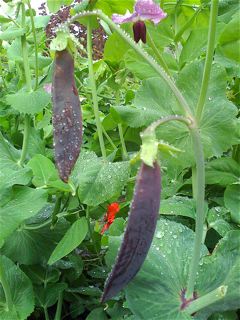 It was an ornate urn planted up with a bunch of rainbow chard that first alerted me to the ornamental possibilities of edibles. Placed where the sun glowed through the chard's luminous, multi-colored stems, the pot was a startlingly gorgeous centerpiece of a formal garden. And it was a bunch of chard!
It was an ornate urn planted up with a bunch of rainbow chard that first alerted me to the ornamental possibilities of edibles. Placed where the sun glowed through the chard's luminous, multi-colored stems, the pot was a startlingly gorgeous centerpiece of a formal garden. And it was a bunch of chard!
How about the pea 'Blauschokker Purple Podded' (above), with red and violet flowers in spring, followed by glossy purple pods that can be eaten early like snow peas or left to ripen? Or the dramatic structure of rhubarb leaves, or gardens hedged in evergreen blueberries (Vaccinium myrsinities 'Sunshine Blue')? No need to choose between edibles and pretty shrubs and flowers, because these days so many plants are both. Some fruits and vegetables are almost too pretty to eat. Make the most of every square foot of soil in your garden with edibles that taste as good as they look.
Chives make a vigorous, spiky little hedge topped with little balls of lavender flowers, golden oregano is as pretty a front-of-the-border plant as you'll find anywhere, and blueberries are handsome plants with striking fall color. Purple or tri-colored sage and rosemary are every bit as useful in the border as clipped, chopped and stirred into soups and stews.
Elegant edible gardening is as much about style of planting as it is about the beauty of the individual plant. You can choose the most gorgeous of vegetables (see list below) and make little of their looks by planting them in rows in the middle of a field. It's a matter of organizing your edibles as ornamentally as you do shrubs, annuals and perennials.
Skirt a purple artichoke with a ruff of silvery artemisia, or mix some ruby-stemmed, fat-leafed rhubarb into a garden bed and you're creating combinations as artful as any in the most ornamental of borders. Of course, it doesn't hurt to start with the best-looking vegetables and cultivars.
The Prettiest Edibles:
Rainbow chard - with luminous stems in shades of yellow through burgundy, this used-to-be-humble vegetable lights up the cool season garden so brightly that it's worth growing even if you never sautéed a leaf. Who needs winter pansies?
Graffiti cauliflower - Graffiti is as solid purple as a grape, so shows up beautifully in the garden. However, it loses its intense color when cooked, so add a splash of vinegar to the water to preserve its drama on the plate.
Rhubarb - grow this ruby-stemmed, statuesque beauty in the flower bed where its fat, textural splay of low-growing leaves contrast pleasingly with most ornamentals.
Kale - kale leaves are thick and krinkled and come in a mix of colors; 'Winter Red' is one of the darkest and showiest.
Meyer Lemon Tree - In most climates these handsome trees need to winter indoors in a conservatory, sunny window, or heated sun porch, although they're surprisingly hardy, surviving temperatures down into the high teens. It's well worth the trouble of dragging their pots inside, for these little trees are easily kept pruned to a manageable size, have fragrant flowers, shiny leaves and bear fruit far more flavorful than standard lemons. Improved Meyer lemon trees come on dwarfing rootstock, which grows into a bushy tree four to six feet tall with bright yellow fruit gratifyingly outsized for the tree's tidy size and shape.
Lettuces - Whether you call them salad bowl lettuces, leaf lettuces, or mesclun mixes, a ruffled mix of them makes a lovely edible groundcover, or trim for a bed or pot. 'Lollo' has deeply curled leaves; 'Merlot' has pretty grape colored leaves and holds up well in the garden, and the bright 'Red Sails' has excellent heat resistance, while the oak leafs have a handsome, distinctive shape. The new butter oak lettuce 'Flashy' has light green leaves splashed with red.
Italian purple artichoke (Artichoke 'Violetto') is a compact version of these most dramatic of edibles, with silvery, spiny foliage that persists through the season, and in summer is topped with showy maroon artichokes.
Fava beans, with their uniquely checkered black and white flowers would be sold as ornamentals if the nutritious beans weren't edible.
Pumpkin vines can grow ratty as the season progresses, but nothing is more spectacular come autumn than pumpkins ripening in the garden. Kids love ghost pumpkins like the tennis-ball sized white 'Baby Boo', whose pallor in the garden is startling. My favorite remains the old-fashioned French heirloom' Cinderella'. This intensely orange/red colored fruit is slightly flattened in shape with deep ridges. It grows easily from seed and is good for eating and for carving. Popular in France since the 1800's, this is the supposedly the pumpkin that Cinderella's fairy godmother turned into a coach with a wave of her wand.
Beets - 'Bull's Blood' has burgundy stems and leaves; 'Chiioggia' has white and pink ringed roots as well as dark leaves. If you leave a few beets to go to seed, they grow into dramatic reddish spires with multiple heads.
Garlic scapes and leeks add height to the garden with their sinuously curving and looping stems and heads.
Runner Beans come in dwarf forms for smaller gardens, with flowers in shades from hot red to orange, pink, white and bi-colored. You an mix in sweet peas, grow them up a big sunflower; grow them on a tripod of sticks to form a shady teepee. 'Sunset' has pink flowers; 'Painted Lady' has flowers that are showy orange and white.